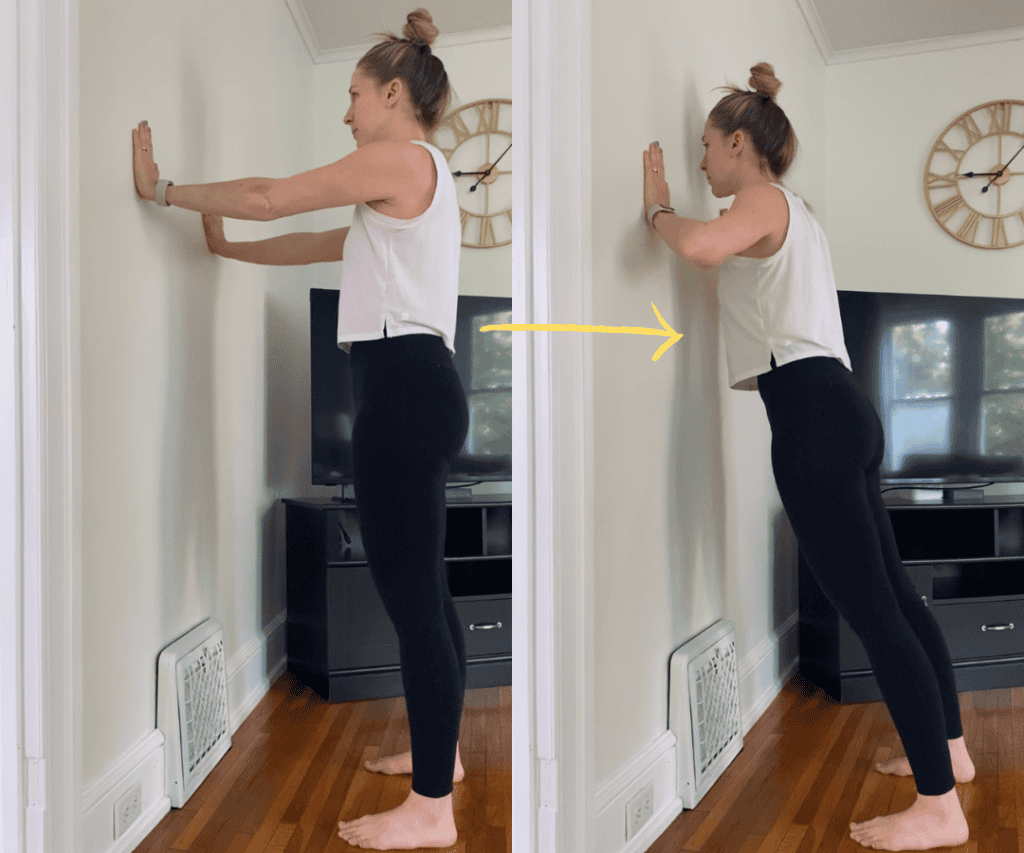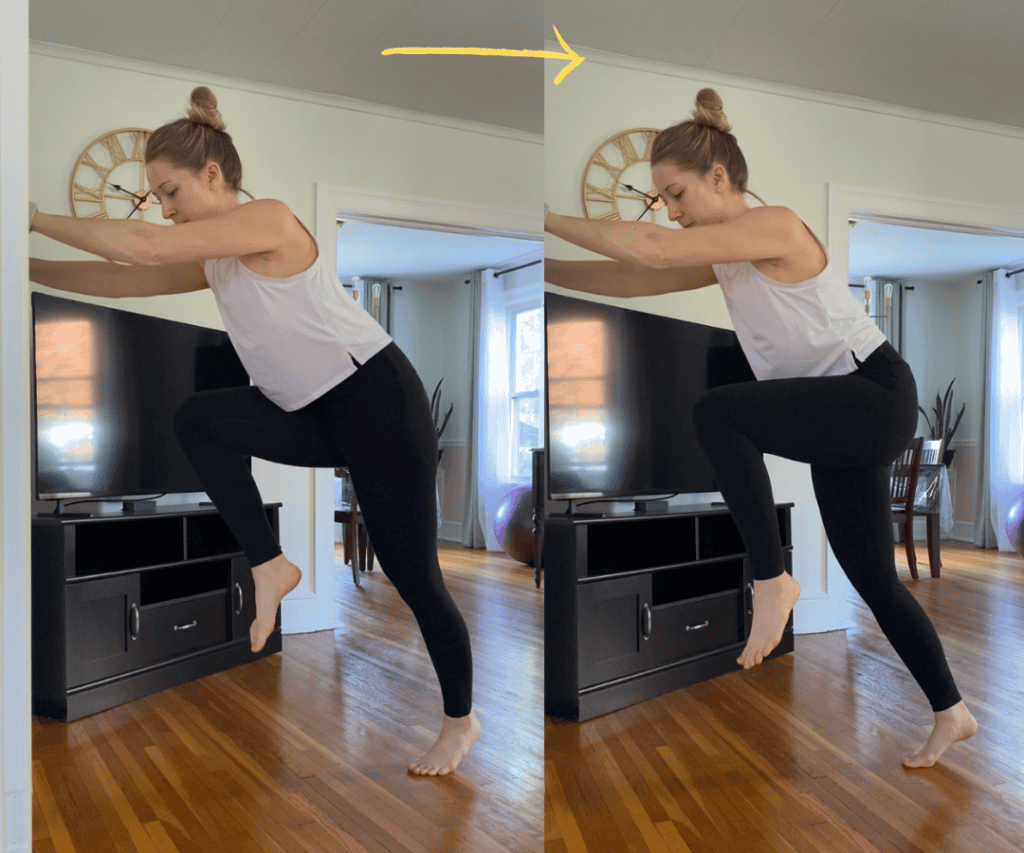10 Best Wall Exercises for Abs
Here are the 10 best wall exercises for abs. You will learn how to do the wall exercises, who they are good for, if you can use them to lose weight, and more.
What are Wall Exercises for Abs?
Wall exercises for abs are abdominal exercises done with the assistance of a wall. The wall serves as a tool to make the abdominal exercises beginner-friendly and somewhat easier. Everyone has access to a wall, making it an inexpensive exercise option.
Wall exercises are an excellent addition to your home workouts. They offer benefits to anyone seeking to enhance their fitness, lose weight, or tone their abdominal muscles.
Do Wall Ab Exercises Work?
Wall ab exercises can be effective for strengthening and toning your core muscles, but their effectiveness depends on various factors, including your fitness goals, proper form, and consistency.
When performed correctly and as part of a well-rounded fitness routine, these exercises can contribute to a stronger, more stable core and improved overall fitness.
However, for visible abdominal definition, it’s important to combine these exercises with an overall reduction in body fat.
Also check out: Bench Ab Workout
10 Best Wall Exercises for Abs
Some of the wall ab exercises might not seem like the typical ab exercise like crunches. However there are different muscles in your core that have different tasks.
The local muscles help stabilize your core (to help prevent injury) and the global muscles help with movement.
By engaging your core throughout all the exercises below, you will strengthen the local core muscles. To engage your core pull your belly button in during the exercise.
#1 Wall Slides

Stand with your back against a wall, ensuring that your feet are about hip-width apart. Your heels, buttocks, upper back, and the back of your head should all be in contact with the wall. Keep your chin tucked in slightly to maintain a neutral neck position.
Raise your arms so that they are parallel to the floor, with your elbows bent at a 90-degree angle. Your hands should be facing forward, and your wrists, elbows, and shoulders should be in contact with the wall.
Tighten your abdominal muscles to stabilize your spine. This will help you maintain the correct posture throughout the exercise.
While keeping your hands, wrists, elbows, and shoulders in contact with the wall, slowly slide your arms upward as far as you comfortably can. Focus on moving your arms smoothly without allowing any part of your upper body to leave the wall.
Hold the top position for a brief moment to feel the stretch in your shoulders and chest. Maintain the engagement of your core muscles.
Slowly slide your arms back down the wall to return to the starting position, with your elbows at a 90-degree angle.
Perform the wall slides for the desired number of repetitions. Start with a small range of motion and gradually increase it as your shoulder mobility improves.
#2 Wall Push Ups

Stand facing a sturdy wall with your feet hip-width apart. Your toes should be pointing straight ahead. Stand far enough from the wall so that when you extend your arms, your palms will be at chest height.
Place your palms flat against the wall, shoulder-width apart. Your fingers should be pointing upward.
Ensure your body is in a straight line from head to heels. Engage your core muscles by pulling your navel toward your spine. Keep your neck in a neutral position by looking at the wall.
Inhale as you slowly bend your elbows, lowering your chest toward the wall. Keep your body in a straight line, and maintain the engagement of your core muscles.
Exhale as you push your body away from the wall by straightening your arms. Focus on using the strength of your chest and triceps to push yourself back to the starting position.
Perform the desired number of repetitions. Start with a manageable number and gradually increase as you build strength.
If this is too easy, move your feet a bit further away from the wall.
#3 Wall Dead Bug

Begin by lying on your back, positioning yourself at a 90-degree angle to the wall.
Place your fists or palms on the wall above you. Press firmly into the wall using your arms as support.
Lift your legs with your knees bent at a 90-degree angle, keeping them in line with your hips.
Extend one leg at a time while alternating sides. Extend the leg until it is just above the level of the floor.
Hold this extended position for 3-5 seconds. Return the extended leg back to the starting position.
#4 Wall Russian Twist

Sit on the floor with your knees bent and your feet touching the wall for support.
Lean your upper body slightly back until you feel tension in your abs.
Keep your back straight and your chest up, maintaining good posture.
Begin the twist by rotating your torso to one side. Maintain your balance by engaging your core muscles. You can touch the floor with both hands next to your hips.
Slowly return to the center position, then move to the other side.
Slowly return to the center position, bringing the weight or hands back in front of your chest.
#5 Wall Ball Squats

Position your feet shoulder-width apart, or slightly wider, with your toes pointing slightly outward.
Ensure that your feet are far enough in front of the ball so that when you squat down, your knees will not go past your toes.
Carefully lean back and press your lower back against the stability ball.
Keep your feet firmly planted on the ground throughout the exercise.
Inhale and engage your core muscles for stability.
Begin to lower your body by bending your knees and hips, as if you’re sitting back into a chair.
Keep your chest up and your back against the ball as you descend. Your knees should track over your toes and not go beyond them.
Continue lowering your body until your thighs are parallel to the ground or as far down as your flexibility allows.
Exhale as you push through your heels to stand back up.
Straighten your legs and return to the starting position, with your knees and hips fully extended.
Keep your back in contact with the stability ball throughout the entire range of motion.
#6 Wall Sits

Stand with your back against the wall and your feel about 1-2 feet away from it. Your feet should be shoulder-width apart, and your toes pointing forward.
Slowly begin to lower your body by bending your knees. Take a step or two forward, so your knees will align with your ankles.
Keep your back straight and press your lower back into the wall as you descend. Continue lowering yourself until your thighs are parallel to the ground, or as close to parallel as you can comfortably go.
Hold the seated position with your thighs parallel to the ground, forming a 90-degree angle at your knees. Your back should be flat against the wall, and your hands can rest on your thighs or be positioned at your sides for balance.
Maintain this position for as long as you can. Beginners may start with 20-30 seconds and gradually increase the duration as they become more comfortable and stronger.
Remember to breathe steadily throughout the exercise. Inhale and exhale slowly and evenly.
When you’re ready to finish the wall sit, push through your heels and gradually stand back up to the starting position.
#7 Wall Plank

Stand facing the wall with your feet together, about arm’s length away from it.
Raise your arms and place your palms flat against the wall, shoulder-width apart. Your fingers should be pointing upward. Your hands should be at approximately chest height.
Tighten your abdominal muscles by pulling your navel toward your spine. This engages your core and helps maintain proper form throughout the exercise.
Begin to walk your feet backward, away from the wall, while keeping your hands pressed firmly against it. Walk your feet back until your body forms a straight line from your head to your heels.
Your arms should be fully extended, and your wrists, elbows, and shoulders should be aligned (or you can fold your ands and let the lower arms touch the wall as seen in the picture).
Ensure that your head, shoulders, hips, knees, and heels are all in a straight line. Keep your neck in a neutral position by looking at the wall.
Hold the wall plank for the desired duration. Beginners may start with 20-30 seconds and gradually increase the time as they become more comfortable and stronger.
Focus on breathing steadily throughout the exercise. Inhale and exhale slowly and evenly.
When you’re ready to finish the wall plank, walk your feet back toward the wall, bringing your body upright. Keep your hands pressed against the wall until you’re in the starting position.
#8 Wall Lunges

Stand up straight with your feet together facing the wall, about 1 foot away. Touch the wall in front of your belly for support.
Maintain good posture throughout the exercise by keeping your back straight, shoulders relaxed, and chest up. Engage your core muscles to help with balance and stability.
Choose one leg to start with and take a step back with that leg. The step should be large enough that when you lunge, both knees bend at approximately 90-degree angles.
The back foot should land on the ball of the foot, with the heel off the ground. Your front knee should be directly above your ankle, and your back knee should hover just above the ground.
Keep your upper body upright and your chest lifted during the lunge.
Push through your front heel to return to the starting position. Perform the same movement with your opposite leg, taking a step back and performing a lunge.
#9 Wall Side Leg Raises

Stand up straight and sideways to the wall with your feet together. One hand touches the wall the other hand rests on your obliques (waist).
Shift your weight onto the leg that is closest to the wall while keeping the other foot flat on the ground.
Slowly lift your non-supporting leg out to the side as far up as you are comfortable.
Engage your core muscles to help with balance and stability. You should feel a crunching motion where you rest your hand (obliques).
Lower your leg back down to the starting position in a controlled manner.
Avoid letting your foot slap back down to the ground; keep the movement smooth and controlled.
Shift your weight onto the opposite leg and repeat the same lifting and lowering motion.
Perform the same number of repetitions on each leg to maintain balance and symmetry.
#10 Wall Mountain Climbers

Place your hands flat on the wall at about shoulder height. Keep your fingers pointing upward, and your palms should be firmly pressed against the wall. Extend your arms fully, keeping them in line with your shoulders.
Maintain a straight and angled line from your head to your heels, engaging your core muscles to keep your body in a plank-like position.
Lift your right knee off the ground and bring it toward your chest. Contract your abdominal muscles as you perform this knee-to-chest movement.
Return your right leg to the starting position. Keep your core engaged and maintain the plank position.
Switch legs. You can do this as fast or as slow as you like.
Are wall exercises good for weight loss?
Weight loss primarily depends on creating a caloric deficit through a combination of factors such as diet and physical activity.
However, I always recommend adding resistance training to your weight loss plan to build muscle mass. During weight loss, approximately 25% of fat-free mass (muscle or organ tissue) is lost.
Incorporating resistance training aids in maintaining or increasing muscle mass, ensuring that most of your weight loss is attributed to fat loss.
Wall exercises for abs can help build muscle mass and can be a beneficial part of your overall weight loss plan. The exercises are specifically great for any exercises beginner and also make a good obese beginner workout.
How many calories can I burn doing the wall exercises for abs?
How many calories you burn during exercise depends on the individual (height, weight, etc.).
Comparing data from studies, we know that sitting burns about 1-2 calories per minute on average, and bodyweight exercises burn up to 5 calories per minute, once your heart rate reaches 120 beats per minute.
It depends on the individual when an exercise will elevate your heart rate to 120 bpm.

If you want to use these wall ab exercises to burn more calories, I suggest doing them a bit faster with no pause in between to elevate your heart rate.
Are these wall exercises good for a flat belly?
These wall exercises can help you on your way to a flat belly. Doing ab exercises does not necessarily mean you will lose fat in your abdominal area. An overall fat loss strategy is essential for reducing body fat in general.
Your body naturally determines where it loses fat first, and unfortunately, we have little control over this process except for losing fat overall.
However, when you do successfully reduce body fat, wall exercises can help tone and shape your belly, giving it a more defined appearance.
How well will wall abdominal exercises build core muscles?
Wall abdominal exercises can be highly effective for building core muscles when performed correctly and consistently.
These exercises engage various muscles within the core, including the rectus abdominis, transverse abdominis, and obliques. The wall provides stability, which can help you focus on proper form and isolate these muscles effectively.
One of the key benefits of wall abdominal exercises is that they reduce strain on the lower back and neck, allowing you to target the core without compromising your posture. Which makes these exercises great for beginners as well.
Wall planks, for instance, provide an excellent isometric contraction for the entire core, helping you develop strength and stability. Wall leg raises, on the other hand, target the lower abdominal muscles and can help tone and strengthen them.
To maximize the effectiveness of wall abdominal exercises, it’s essential to maintain proper form and gradually increase the intensity over time.
How to get the best out of your wall ab exercises
To get the best results from your wall ab exercises and maximize their effectiveness, consider the following tips:
Maintain Proper Form: Proper form is crucial for targeting the intended muscles and avoiding strain or injury. Ensure your body is aligned correctly, engage your core muscles, and avoid excessive arching or sagging in your back or hips.
Gradually Increase Intensity: Start with exercises that match your fitness level and gradually progress to more challenging variations. Increasing the intensity can involve extending the duration, adding resistance, or incorporating dynamic movements.
Focus on Control: Emphasize controlled movements during your wall ab exercises. This control not only engages your muscles effectively but also reduces the risk of injury.
Consistency is Key: Incorporate wall workouts for abs into your regular workout routine. Consistency over time is essential for building strength and seeing progress.
Mix It Up: Don’t stick to just one type of wall ab exercise. Include a variety of exercises to target different aspects of your core and keep your workouts engaging.
Rest and Recovery: Allow your core muscles time to recover between workouts. Overtraining can lead to injury and hinder progress.
Seek Professional Guidance: If you’re unsure about your form or which exercises are best for your fitness level, consider working with a fitness trainer or coach who can provide personalized guidance and support.
Listen to Your Body: Pay attention to your body’s signals. If you experience pain or discomfort during any exercise, modify it or consult a fitness professional for guidance.
By following these tips and incorporating wall ab exercises into a comprehensive fitness routine, you can effectively build and strengthen your core muscles, leading to better overall fitness and potentially visible abdominal definition.
FAQs: Wall Exercises for Abs
Absolutely! Wall ab exercises can be excellent for beginners. They provide stability and support, making it easier to maintain proper form and reduce the risk of injury. Beginners can start with basic wall exercises like wall planks and leg raises and gradually progress to more challenging variations as their core strength improves. These exercises are versatile and can be adapted to suit various fitness levels, making them accessible for everyone.
Beginners: As mentioned earlier, wall exercises are beginner-friendly due to the support they offer, making them an excellent choice for those new to fitness.
People with Lower Back Issues: Wall exercises can be gentler on the lower back compared to traditional floor exercises, making them a good option for individuals with lower back concerns.
Those Aiming for Better Posture: Wall exercises can help improve posture by strengthening the core muscles responsible for maintaining an upright position.
Anyone Interested in Core Strengthening: Whether your goal is to tone your stomach with this workout, reduce the risk of lower back pain, or achieve better overall core strength, wall exercises for abs can be a valuable addition to your fitness routine.
The frequency of wall ab exercises depends on your fitness goals and your overall workout routine. Generally, incorporating them 2-3 times per week alongside other core-strengthening exercises can lead to noticeable improvements in core strength and muscle tone. However, it’s essential to allow your muscles time to recover, so avoid doing intense core workouts on consecutive days. Listen to your body and adjust the frequency as needed to prevent overtraining.
Wall ab exercises can contribute to a stronger core and toned abdominal muscles, but achieving a visible six-pack or defined abs also requires a low body fat percentage. To reveal well-defined abs, you need to combine core-strengthening exercises with a balanced diet and cardiovascular exercise to reduce overall body fat.







